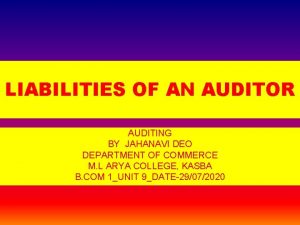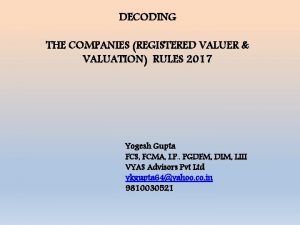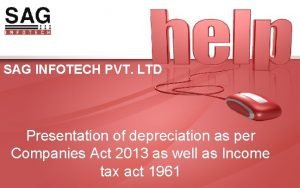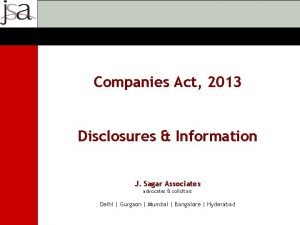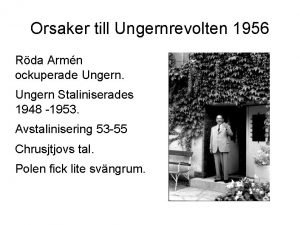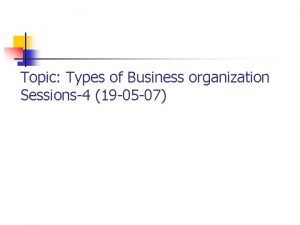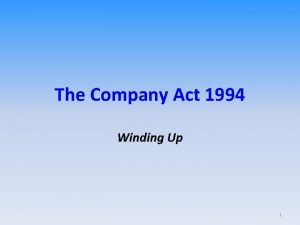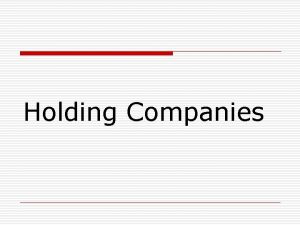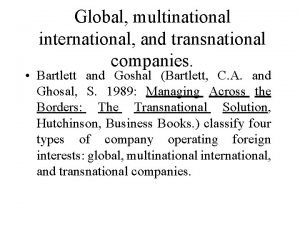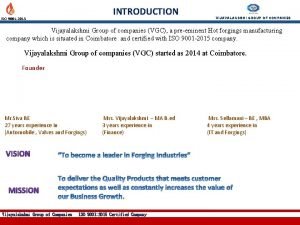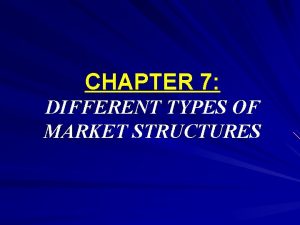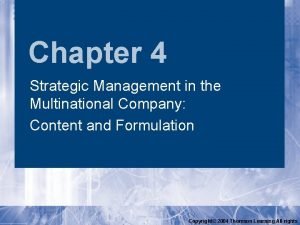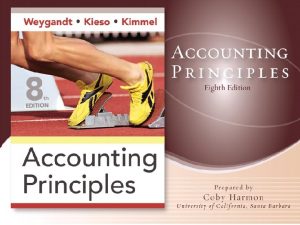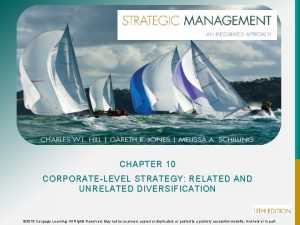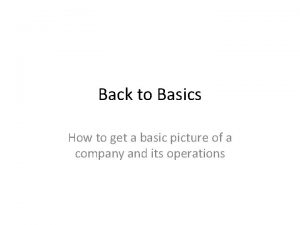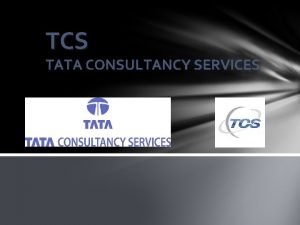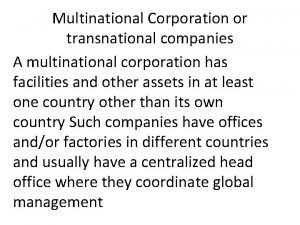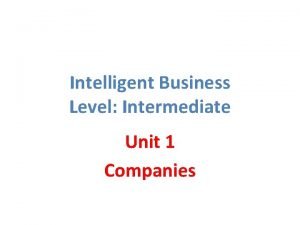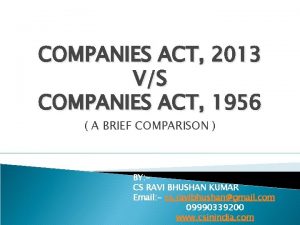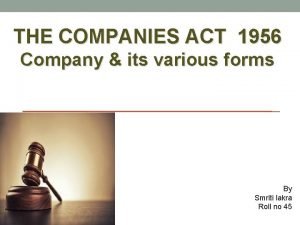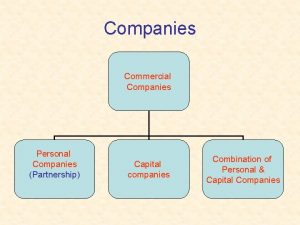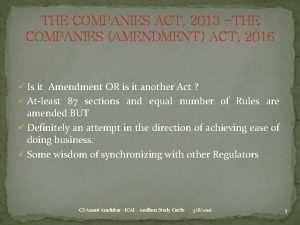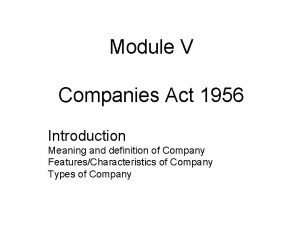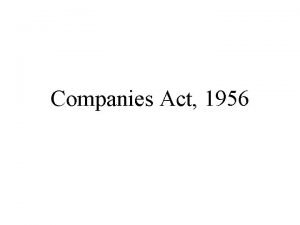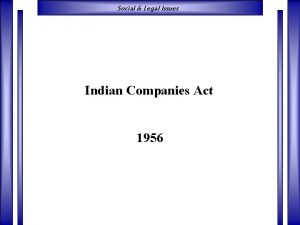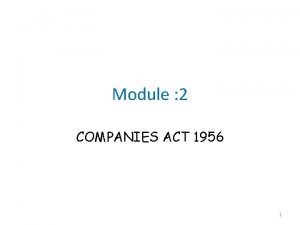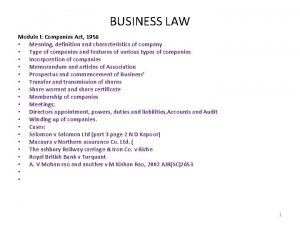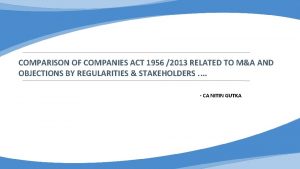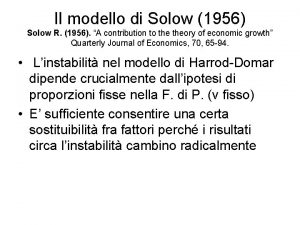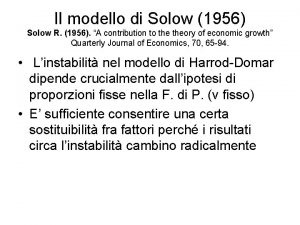The Companies Act 1956 n n n Company



























































































































- Slides: 123

The Companies Act 1956 n n n Company means a group of persons associated together for the attainment of common goal- social and economic; “Company is an artificial person, having voluntary association of persons, formed for some common purpose, has divisible capital known as shares. ” Companies Act 1956 Characteristics of Company: Separate Legal Entity (Soloman Vs. Soloman and Company); n Limited Liability: n A Company Limited by shares; n A Company Limited by Guarantee; -- Perpetual Succession; – Common Seal; – Transferability of Shares; Dr. Ritu Arora (Associate Professor) 1 n

Kinds of Companies n 1. 2. n Classification on the basis of Incorporation: Statutory Companies: Companies which are created by the special act of the Legislation e. g. Railways, Postage etc. ; Registered Companies: Companies which are formed and registered under the Companies Act 1956. Classification on the basis of Liability: 1. 2. Companies with Limited Liability • Companies Limited by Shares; n Companies Limited by Guarantee. Un-Limited Companies: An Unlimited company may or may not have a Share Capital. Dr. Ritu Arora (Associate Professor) 2

Kinds of Companies n Classification on the basis of no. of members: n Private Company: n It is a company which restricts the transfer of shares, if any. This restriction is meant to preserve the private character of the company; n Limits the number of its members to 50 not including its employee- members; n Prohibits any invitation to the public to subscribe for any shares in, or debentures of, the company. Public Company: • Minimum number of members in a public company is 7 and there is no restriction on maximum no. of members in a Public Company; • In Public Limited Company the shares and debentures are freely transferrable. n Dr. Ritu Arora (Associate Professor) 3

Kinds of Companies n Classification on the basis of Control: n n 1. 2. 3. n Holding Company; Subsidiary Company; Company Controlling Composition of Board of Directors; Holding of Majority of Shares; Subsidiary of another subsidiary. Classification on the basis of Ownership: 1. 2. 3. Government Company; Non-Government Company; Foreign Company Association Not for Profit; • One Man Company. • Dr. Ritu Arora (Associate Professor) 4

Distinction Between a Private company and Public Company 1. 2. 3. Minimum number : Minimum no. of persons required to form a public company is 7. It is 2 in case of private company; Maximum number: There is no restriction on maximum no. of members in a Public company, whereas the maximum no. Cannot exceed 50 in a private company; Restriction on appointment of directors : In the case of Public Company, the directors must file with the registrar a consent to act as directors or sign an undertaking for their qualification shares. The directors of private company need not to do so. Dr. Ritu Arora (Associate Professor) 5

4. 5. 6. 7. Restriction on invitation to subscribe for shares : A public company invites the general Public to subscribe for the shares in, or the debentures of the company. A private company by its articles prohibits any such invitation to the public. Transferability of shares and debentures : In a public company, the shares and debentures are freely transferrable. In a private company the fight to transfer shares and debentures is restricted by the Articles. Quorum : if the Articles of a company do not provide for a larger quorum , 5 members personally present in the case of public company are quorum for a meeting of the company. It is 2 in the case of a private company. Managerial Remuneration : total management remuneration in a public company cannot exceed 11% of the net profits. No such restrictions applies to a private company. Dr. Ritu Arora (Associate Professor) 6

Doctrine of Ultra Vires Ultra means “Beyond” and Vires means “powers”. The term Ultra Vires Means that the doing of the act is beyond the legal power and authority of the company. The purpose of these restrictions is to protect: 1. The investors in the company so that they may know the objects in which their money is to be employed; 2. Creditors by ensuring that the company’s funds are not wasted in unauthorized activities. Dr. Ritu Arora (Associate Professor) 7

When Does a private company become a Public company I. II. a) b) c) III. Conversion by Default (sec 43): Where a default is made by a private company in complying with the essential requirements of a private company, the company ceases to enjoy the privileges and exemptions conferred to a private company; Conversion by operation of law (Sec 43 A); Where the private holds not less than 25% of the paid-up share capital of a Public company, having a share capital. Where the private company invites, accepts or renews deposits from the public. Where not less than 25% of the paid up capital of the private company is held by one or more bodies corporate. Conversion by Choice or violation. Conversion of a Public Company in to Private company v By passing special Resolution, but only after the prior permission of the Central Govt. Dr. Ritu Arora (Associate Professor) 8

Memorandum of Association is a charter of company, which defines the reason for its existence, lays down the area of operation of company, regulates the external affairs of the company in relation to outsiders. Purpose : v Its purpose is to enable shareholders and those who deal with the company to know what its permitted range of enterprise is. Printing and Signing of Memorandum: v Printed; v Divided in to paragraphs numbered consecutively, and v Signed by 7(2 in case of Private company) subscribers, with address, description and occupation, in any in the presence of atleast 1 witness who shall attest the signature and shall likewise add his address, description and occupation, if any. Form of Memorandum : Should be the Forms of Tables B, C, D and E. Dr. Ritu Arora (Associate Professor) 9

Contents/Clauses of Memorandum (Sec. 13) 1. a) b) c) d) e) Name Clause (Sec 20) : The company may subject to the following rules, select any suitable name : Undesirable name to be avoided: i. e. too similar to the name of another company, misleading etc. Injunction if identical name adopted; “Limited” or “Private Limited” as the last word or words of the name. Prohibition of use of certain name; Use of some key words according to authorized capital: Dr. Ritu Arora (Associate Professor) 10

Key Words a) b) c) d) Corporation International, Globe, Universal, Continental, Inter - Continental, Asiatic, Asia, being the first words of the name. If any of the words at (ii) above is used within the name (with or without brackets). Hindustan, India, Bharat, being the first word of the name; Required Authorized Capital 5 Crores 1 Crores 50 Lakhs Dr. Ritu Arora (Associate Professor) 11

e) If any of the words at (iv) above is used (with or without brackets); f) Enterprises, products, Business, Manufacturing. g) Industries and Udyog 5 Lakhs 10 Lakhs 1 Crore. Publication of Name (Sec. 147) 2. Registration Office Clause (Sec. 146); 3. The Objects Clause (Sec. 13(1)): Divided in to two parts: (I) Main Objects; (II) Other Objects; 4. The Capital Clause (Sec. 13 (4)); 5. The Liability Clause (Sec. 13 (2)); 6. The Association Clause (Sec. 13 (4)). The Memorandum shall be signed and attested (by at least 1 person) by at least 7 subscribers in the case of Public Dr. Ritu (Associate Professor) 12 Company and 2 in the. Arora case of private company.

Alteration of Memorandum 1. v v 2. v v Change of names: By special Resolution with the approval of the central Govt. signified in writing: Only the deletion or addition of word “private” on the conversion of a public company in to private company or vice versa does not require the approval of the central government. In case the name of the company is nearly same as the name of the other company, the company can change its name by merely passing an ordinary resolution Fresh certificate of incorporation. Change of Registered Office: Notice to be given within 30 days after the date of the change to the registrar who shall record the same ; Also a notice to the affected parties; Confirmation by the Company law of Board; Dr. Ritu Arora (Associate Professor) 13 Notice to Registrar;

v v v 3. v v v 4. 5. Power of the company law board to confirm change descretionary; Rights and interests of members and creditors to be taken care of; Copy of special resolution (within 1 month) and the order of the company Law Board to be filed with the registrar (with in 3 months of the order). Alteration of objects : Special resolution shall be passed in general meeting; Copy of special resolution shall be filed with registrar with in 1 month from the date of resolution with a printed copy of memorandum altered; Certificate of registration to be issued by the registrar with in one month from the date of filing of the special resolution. Change of Liability Clause; Change in Capital Clause. Dr. Ritu Arora (Associate Professor) 14

Articles of Association The articles of association are the rules, regulations and byelaws for the internal management of the affairs of a company. They are framed with the object of carrying out the aims and objects as set out in the Memorandum of Association. In framing the Articles of a company care must be taken to see that regulations framed do not go beyond the powers of the company itself as contemplated by the memorandum of Association. Companies which must have their own articles: Unlimited companies; v Companies Limited by Guarantee; v Private companies limited by shares. The articles shall be signed by the subscribers of the Memorandum and registered along with the Memorandum. A public company may have its own Articles. If it does not have its own Articles, it may adopt Table a given in Schedule 1 to the Act. v Dr. Ritu Arora (Associate Professor) 15

Contents of Articles: 1. 2. 3. 4. 5. 6. 7. 8. 9. 10. 11. Capital, rights of shareholders, variation of these rights, payment of commission, share certificate; Lien of Shares; Calls on shares; Transfer of shares; Transmission of shares; Forfeiture of shares; Conversion of shares in to stock; Share Warrants; Alteration of capital; General Meetings and Proceedings thereat; Voting rights of members, voting and poll, proxies; Dr. Ritu Arora (Associate Professor) 16

12. 13. 14. 15. 16. 17. 18. Directors, their appointments, remuneration, qualification, powers and proceedings of Board of Directors; Manager; Secretary; Dividends and Reserves; Accounts, audit and borrowing powers; Capitalisation of profits; Winding Up. Dr. Ritu Arora (Associate Professor) 17

Regulations required in case of an Un Limited Company, a Company Limited by Guarantee and a private Company: 1. q q 2. 3. q q q Un-Limited Company: In case of an Un limited company, Articles shall state: The no. of members with which the company is to be registered, and; If it has a share capital, the amount of share capital with which the company is to be registered; Company Limited by Guarantee: In case of a company Limited by guarantee, the Articles shall state the no. of members with which the company is to be registered; Private Company: In the case of a Private company having a share capita, the Articles shall contain provisions which: restrict the right to transfer shares; limit the no. of its members to 50 (not including employeemembers), and; Arora (Associate 18 prohibit any invitation Dr. to. Ritu the public to. Professor) subscribe for any shares in,

Adoption and Application of Table A: The are 3 alternative forms in which a Public company may adopt Articles: 1. It many adopt Table a in full; 2. It may wholly exclude Table A and set out its own Articles and adopt Part of Table A; 3. It may frame its own Articles of a Public Company expressly exclude any or all provisions of Table A, Table a shall automatically apply to it Form of Articles in the case of other companies: Articles of any company, not being a company limited by shares, shall be in such one of the forms in Tables C, D, E in schedule 1 to the act, as may be applicable, or in form as near there to as circumstances admit. Dr. Ritu Arora (Associate Professor) 19

Forms and signature of Articles: 1. 2. 3. Printed; Divided in to Paragraphs; Signed by each subscriber of the Memorandum (who shall add his address, description and occupation, if any) in the presence of at least 1 witness who will attest the signature and likewise add his address, description and occupation. if any. Dr. Ritu Arora (Associate Professor) 20

Alteration of Articles Generally its not possible, to alter its Articles of Association. But a company may, by passing a special resolution, alter its Articles any time. A copy of every special resolution altering the articles shall be filed with the Registrar within 30 days of its passing and attached to every copy of the Articles issued thereafter. Any alteration is so made in the articles shall be as valid as if originally contained in the Articles. Limitations to alteration: q Must not be inconsistent with the Act; q Must not conflict with the Memorandum; q Must not sanction anything illegal; q Must not increase liability of members; q Must be for the benefit of the company; Dr. Ritu Arora (Associate Professor) 21

q q q Alteration by special resolution only; Approval of Central Govt. When a Public company is converted in to Private company; Breach of Contract; Must not result in expulsion of a member; No power of the court to amend articles; Alteration may be with retrospective effect. Dr. Ritu Arora (Associate Professor) 22

Articles and Memorandum- their Relation 1. 2. 3. The Articles are subordinate to Memorandum; The Memorandum must be read in conjunction with Articles; The terms of the Memorandum cannot be modified or controlled by the Articles; Articles and Memorandum – Distinction Memorandum of Association q It is the charter of the company, defined the relationship of the company with the outside world; Articles of Association q They are the regulation of the internal management and the subsidiary to the management; Dr. Ritu Arora (Associate Professor) 23

q It defines the scope of the activities of the company, or the area beyond which the action of the cannot go; q They are the rules of carrying out the objects of the company; q It is the supreme document ; q They are subordinate the Memorandum; q Every company must have its own Memorandum; q A company limited shares need not have Articles of its own; q There are strict restriction on its alteration; q They can be altered by special resolution; q Ultra wires act cannot be altered; q Acts Ultra wires to Articles can be altered. Dr. Ritu Arora (Associate Professor) 24

Legal Effect of the Memorandum and Articles 1. 2. 3. 4. Members to the Company: Both Memorandum and Articles of the Company constitute a binding contract between the company and its members; Company to the Members: A company id bound to the individual members in terms of their ordinary rights as members e. g. the right to receive notice of general meeting, the right to receive dividend etc. Members inter se: as between members inter se (among themselves) the Memorandum and the Articles constitute a contract between them and are also binding on each member as against the other or others. Such a contract can, however, be enforced through the medium of the company; Dr. Ritu outsiders Arora (Associate Professor) 25 Company to the : the articles do not

Prospectus Sec 2 (36) defines a prospectus as “any document described or issued as a prospectus and includes any notice, circular, advertisement or other document inviting deposits from the public or inviting offers from the public for subscription or purchase of any shares in, or debentures of, a body corporate. ” In simple words, any document inviting offers from the public for the subscription of shares or debentures of a company is a prospectus. The central theme of a prospectus, from the money point of view, is that it sets out the prospects of the company and the purpose for which the capital is required. It is essential for the public company to issue prospectus but as private company Dr. is. Ritu prohibited from making any invitation Arora (Associate Professor) 26 to the public, hence it need not issue a prospectus.

Characteristics of a Prospectus It should be in writing; q Invitation to the public; q To the public, i. e. public issue : How many persons constitute public ? Public includes “any section of the public whether elected as members or debenture holders, or as clients of the person issuing the prospectus or in any other manner” sec. 67. q Dating of prospectus (sec. 55) : Date of issue must be there on the prospectus; q Signing of prospectus (sec. 55) : It has to be singed by the proposed directors of the company or by their agents authorised in writing. q Dr. Ritu Arora (Associate Professor) 27

q Registration of prospectus : (sec. 60) : copy of prospectus must be delivered to the registrar for registration. This registration must be made before or on the date of publication there of copy must be signed by every person whose name therein as director or proposed director of the company. The prospectus must be issued within 90 days of the date on which a copy there of being delivered to the registrar for registration. Dr. Ritu Arora (Associate Professor) 28

Penalty for non registration of prospectus: If a prospectus in issued without a copy there of being delivered to the registrar for registration, or without the necessary documents or the consent of experts, the company and every person, who is knowingly a party to the issue of the prospectus, shall be punishable with fine, which may extend to Rs. 5000/- Objects of registration of prospectus: 1. 2. To keep an authenticated record of the terms and conditions of issue of shares and debentures ; To pinpoint the responsibility of the persons issuing the prospectus for statements made by them in the prospectus. Contents of Prospectus Matters to be stated and reports to be set out in prospectus (sec. 56) 1. 2. State the matters specified in Part 1 of Schedule II, and ; Set out the reports specified in Part II of Schedule II 29; Dr. Ritu Arora (Associate Professor)

The important contents of the Prospectus are as follows: Ø 1. a) b) c) d) e) Part I of Schedule II : General Information : Name and address of the registered office of the company : Consent of the Central Gove. For the present issue and declaration of the Central govt. About non responsibility for financial soundness or correctness of statements : Name of regional stock exchanges and other stock exchanges where application is made for listing of present issue ; Declaration about refund of the issue if minimum subscription of 90% is not received within 90 days of closure of the issue; Declaration about the issue allotment/ Refund 30 Dr. Ritu Arora (Associate of Professor)

a) b) c) 2. a) b) c) I. II. 3. a) b) Date of opening and closing of the issue; Name and address of auditors and lead managers; Name and address of trustees under debenture trust deed; Capital structure of the company : Authorised, issued, subscribed and paid up capital; Size of present issue giving seperately reservation for preferential allotment to promoters and others; Pain up capital : After the present issue; After conversion of debentures (if applicable). Terms of the present issue: Terms of payments; Rights of the instruments holder; Dr. Ritu Arora (Associate Professor) 31

a) b) 4. a) b) c) 5. 6. 7. a) How to apply-availability of forms, prospectus and mode of payment; Any special tax benefits for company and its shareholders; Particulars of the issue: Objects; Project Cost; Means of financing (including contribution of promoters). Company, management and projects; Particulars in regard to the company and other listed companies under same management; Outstanding litigation pertaining to: Matters likely to affect operation and finance of the company including disputed tax liabilities of any Dr. Ritu Arora (Associate Professor) nature, and criminal prosecution launched against 32

b) c) Ø A. B. a) b) C. Ø Ø 1. Particulars of default, if any, in meeting statutory dues, institutional dues and dues towards debentureholders fixed depositors; Any material developments after the date of the latest balance sheet and their likely impact. Part II of the Schedule II: General Information; Financial information: Report by Auditors; Reports by the accountants; Statutory and other information: Minimum subscription; Expenses of the issue giving separately fees payable to: Advisors; Dr. Ritu Arora (Associate Professor) 33

2. 3. 4. Ø Ø Ø Ø Ø Registrar to the issue; Managers to the issue; Trustees for the debenture-holders. Underwriting commission or brokerage; Previous issue for cash; Previous public and rights issue, if any (during last 5 years); Date of allotment: closing date; Date of refunds: date of listing on the stock exchange; Premium of any, on each share which had been issued with in the – 2 years preceding the date of the prospectus; Commission or brokerage on previous issue; Issue of shares otherwise than for cash; Details of purchase of society; Details of directors, proposed directors, whole time directors, their remuneration, appointment and remuneration of managing directors, interests of directors, their borrowing powers and qualification shares. Dr. Ritu Arora (Associate Professor) 34

Misstatements in Prospectus and their consequences If there is any misstatement of a material afact in a prospectus or if the prospectus is wanting in any material fact, there may arise: 1. Civil Liability; 2. Criminal Liability. Dr. Ritu Arora (Associate Professor) 35

Liability for Misstatement in Prospectus Civil Liability Against the Company Recession of Contract Criminal Liability (fine Rs. 5000/- or /& 2 yrs. jail) Against the directors, Promoters & Experts Claim for Damages (for fraudulent misrepresentation) Damages Compensation Under sec. 62 With sec. 56 Damages for non – compliance For innocent misrepresentation Dr. Ritu Arora (Associate Professor) 36

Promoter Who? A promoter is a person who does the necessary preliminary work incidental to the formation of a company. Functions: a) b) c) d) e) Decides the name of the company; Settles the details of the company’s Memorandum and Articles of association; Settles the details of nomination of Directors, solicitors, bankers, auditors and secretary and the Registered office of the company and He arranges of Printing of Articles and Memorandum of Association, the registration of the company, the issue of prospectus, where a public issue is necessary; He is responsible for bringing the company in to existence for the object which he has in view. Legal status of a promoter: Dr. Ritu Arora (Associate Professor) 37 As to the exact legal status of a promoter, the statutory provisions

Fiduciary position of a promoter (means relations requiring confidence and trust) Not to make any profit at the expense of the company; v To give benefit of negotiations to the company; v To make a full disclosure of interest and profit; v Not to make unfair use of position. Duty of promoter as regards to prospectus: The promoter must see, in connection with the prospectus, if any is issued (or the statement in lieu of prospectus), that the prospectusv Contains the necessary particulars; v Does not contain any material fact. v Dr. Ritu Arora (Associate Professor) 38

Remuneration of promoters: A promoter has no right to get compensation from the company for his services in promoting the company unless there is a contract to that effect. In practice, a promoter takes remuneration for his services in one of the following ways: v He may sell his property at the profit to the company for cast or fully paid shares provided he makes a disclosure to this effect; v He may be given an option to buy a certain number of fully paid shares in the company at par; v He may take a commission on the shares sold; v The company may pay him a lump sum. Position of promoters as regards Pre Incorporation contracts: v Company is not bound by pre incorporation contracts; v Company cannot enforce pre-incorporation contracts; 39 Dr. Ritu Arora (Associate Professor)

Formation of Company Companies are formed by certain persons known as “Promoters”. They do all the necessary preliminary work incidental to the formation of a company. Incorporation of a Company (Sec. 12): Any seven or more persons (2 in case of a Private company) associated for any lawful purpose may form an incorporated company, with or without limited liability. Documents to be filed with Registrar: 1. The Memorandum of Association duly signed by the subscribers; 2. The Articles of Association (no Articles of Association in case of Public Company limited by Shares, if any, signed by the subscribers to the Dr. Ritu Arora (Associate Professor) 40 Memorandum of Association;

3. 4. 5. a) b) c) d) The agreement, if any, which the company proposes to enter into with any individual for appointment as its managing or whole-time director or manager; A list of the Directors and their written consent to act as directors and take up qualification shares; A declaration stating that all the requirements of the companies Act and other formalities relating to registration have been complied with. Such declaration shall be signed by any of the following persons: An advocate of the Supreme Court or of a High Court: or Am attorney or pleader entitled to appear before a high Court; or A secretary or a chartered accountant in whole time practice in secretary of the company; Within 30 days of the date of incorporation of the company, a notice of the situation of the registered office of the company shall be given to the Registrar who shall record the same. Dr. Ritu Arora (Associate Professor) 41

Certificate of In-Corporation (Conclusive Evidence) When the requisite documents are filed with the Registrar, the Registrar shall satisfy himself that the statutory requirements regarding the registration have been duly compiled with. If the registrar is satisfied as to the compliance of statutory requirements, he issues a “a certificate of Incorporation” i. e. , the formation of the company. Effects of Registration v The company becomes a distinct legal entity; v The company acquires a perpetual succession; v The company’s property is not the property of the shareholders; Dr. Ritu Arora (Associate Professor) 42

Shares n n n A share is the interest of a shareholder in a company. The capital of a company is divided in to certain indivisible units of a fixed amount. These units are called shares. Shares : “Bundle of rights and obligations” A share is evidenced by a share certificate. A share is issued by a company under its common seal. It specifies the shares held by a member and is prima facie evidence of the title of the member to the shares. Each share to be distinguished by appropriate number. Shares are the movable property transferable in the manner provided by the Articles of association. Dr. Ritu Arora (Associate Professor) 43

Stock and shares: Stock is the aggregate of fully paid up shares, consolidated and divided, for the purpose of convenient holding in to different parts. It may be transferred or split up in to fractions of any amount, without regard to the original face value of the share. A company limited by shares may, authorized by its Articles, by ordinary resolution passed in a general meeting, convert its fully paid up shares in to stock. When shares are converted in to stock, notice shall be given to the registrar within 30 days of the conversion. The register of members shall then show the amount of stock held by each of the members concerned instead of the amount of the shares. Dr. Ritu Arora (Associate Professor) 44

Conversion of shares in to stock: Articles 36 to 39 deals with the conversion of shares in to stock. Ordinary Resolution: n n Convert any paid up share in to stock; and Reconvert any stock in to paid up shares of any denomination Transferability: The holder of stock may transfer the stock or any part there of in the same manner as the shares from which the stock arose. The board of directors may, from time to time, fix the minimum amount of stock transferable. But such minimum amount of shares from which the stock arose. Rights and privileges: The holders of stock shall, according to the amount of stock held by them, have the same rights, privileges and. Professor) advantages as regards Dr. Ritu Arora (Associate 45

Effects of conversion of shares in to stock: all the provisions of the Company Law which are applicable to shares only, shall cease to apply to shares capital which is converted in to stock. Stock and shares – Distinction: a) A share has a nominal value, whereas stock has no nominal value; b) Stock is always fully paid up, while share may not be go; c) Stock is transferable in small fractions while shares can only be transferred in round numbers; d) All shares are of equal denomination. Stock may be of unequal amounts; e) The fractions or parts of stock do not bear any Dr. Ritu Arora (Associate Professor) 46 distinctive numbers while shares always bear

f) Shares can be directly issued to the public whereas stock cannot be issued directly. Only fully paid up shares can be converted in to stock. Application and Allotment of shares An application for shares is an offer by a prospective shareholder of a company to take shares. “Allotment” is the acceptance by the company of that offer. It results in a binding contract between the company and the applicant. The following provisions of the act are applicable to “application” for and allotment of shares: Dr. Ritu Arora (Associate Professor) 47

1. Minimum Subscription: 2. Application Money: n must receive minimum of 90% subscription. Otherwise the entire amount collected will be refunded to the shareholders at the end of the 90 days from the closure of issue. If there is a delay in refund of such amount by more than 10 days, the company will pay interest at the rate of 15% p. a. for the delayed period. The amount payable on application on each share shall not be less than 5% of the nominal amount of the share. The capital issued must be made fully paid up with in 12 months from the date of issue. 3. Effect of irregular allotment: n Where the company has issued a prospectus, the allotment is irregular if it: Dr. Ritu Arora (Associate Professor) 48

a) b) c) n Has not been able to raise the amount of minimum subscription; Has not collected application money (which shall not be less than 5% of the nominal amount of the shares); and Has not kept the money so received in a Scheduled Bank. Where the company has not issued a prospectus, the allotment is irregular if it does not file with the registrar for registration, a statement in lieu of prospectus at least 3 days before the first allotment of shares. The effects of irregular allotment: a) Allotment is voidable: Dr. Ritu Arora (Associate Professor) 49

4. 5. 6. Opening of the Subscription List: Allotment can be made only after the beginning of the 5 th day from the date of the issue of the prospectus or on such later day as may be specified in the prospectus. This beginning of the 5 th day is known as “the opening of the subscription list”. Shares and Debentures to be listed in on a stock exchanges; Return of money on refusal of payments: where the permission has not been granted, the company shall forthwith repay without interest all moneys received from applicants in pursuance of the prospectus. If any such money is not repaid within 8 days after the company becomes liable to repay it, the company and every director of the company who is an officer in default shall, on or from the expiry of the 8 th. Dr. day, be jointly or severally liable to 50 Ritu Arora (Associate Professor)

a) b) Not less than 4% and not more than 15% as may be prescribed; Having regard to the length of the period of delay in making the repayment to such money. 7. Right of appeal: where a stock exchange a) refuses to grant an application or fails to dispose it of within 10 weeks (in which case it will be deemed to have been rejected), the company may appeal to the Central Government against the refusal. The appeal shall be filed: Within 15 days from the date of the refusal; or Within in 15 days from the date of the expiry of the 10 weeks. Return of Excess money where permission granted; Dr. Ritu Arora (Associate Professor) All money to kept in a separate bank account in a 51 b) 8. 9.

10. a) b) c) d) Return as to allotment: within 30 days of allotment of shares by a company, the company shall file with the Registrar a statement known as “return as to allotments”. The return shall contain: Particulars about the shares allotted fro cash, the names, addresses and occupations of the allotees, and the amount paid on each share; Particulars about the shares allotted as fully or partly paid up for any consideration other than cash; Particulars about the bonus shares and the names, addresses and occupations of the allotees and a resolution authorising the issue of such shares; A copy of resolution passed by the company authorising issue at a discount, and a 52 Dr. Ritu of Arora shares (Associate Professor)

11. Calls on shares: A call is a deemed by a company on its shareholders to pay the whole or part of the balance remaining unpaid on each share. It is made in pursuance of a resolution of the Board of Directors and terms of the Articles. It may be made any time during the lifetime of the company or during its winding up. Share certificate a) b) c) Every person whose name is entered as a member in the register of members of a company has a right to receive a certificate of his shares. A share certificate shall be under the seal of the company, and shall specify: The shares to which it relates; The amount paid up there on; The name of the holder of the shares. The share certificate shall be signed by. Professor) at least 2 directors and Dr. Ritu Arora (Associate 53

Limitations of time for issue of share certificate: The company shall deliver share certificate – a) Within three months of the allotment of shares, or b) Within two months after the application for registration of the transfer of any shares Lost or defaced certificate: a) b) A certificate may be renewed or a duplicate of a certificate may be issued if such certificate – Is proved to have been lost or destroyed; Having been defaced or mutilated or torn, is surrendered to the company. Dr. Ritu Arora (Associate Professor) 54

Share Warrant A share warrant is a document issued by a public company stating that its bearer is entitled to the shares specified therein. It is transferable by mere delivery and is a substitute for the share certificate. Conditions for issue of share warrant: The shares shall be fully paid up; • The Articles shall authorize the issue of share warrants; • Prior approval of the Central Govt. shall be obtained; • The share warrants shall be issued under the common seal of the company; • The holder of a share warrant is entitled to the shares specified therein and the shares may be transferred by delivery of the share warrant. ; Dr. Ritu Arora (Associate Professor) 55

Difference between a share warrant and a share certificate: • • • All companies are required to issue share certificates. Share warrants can be issued only by public companies; If it is empowered by its Articles of Association only then public company will issue share warrant. There is statutory obligation on every company to issue share certificate; A share warrant can be issued only with respect to fully paid up shares. A share certificate is to be issued even where the shares partly paid up; A holder of a share certificate is a member of the company but the holder of a share warrant is not a member unless the Articles otherwise provide; A share warrant is by mercantile usage a negotiable instrument. A share certificate is not; Dr. Ritu Arora (Associate Professor) 56

• • No stamp duty is payable on transfer of a share warrant whereas stamp duty is payable on transfer of shares specified in share certificate; Where is director is required to hold some qualification shares, a share warrant does not constitute such a qualification whereas a share certificate does; A share certificate is a document showing prima facie title to the shares presented thereby. A share warrant is the share security itself, transformed for the purpose of negotiation into a different character; Dividend is paid to the holder of a share certificate by issue of a dividend warrant in his favor. Dividend due on a share warrant is advertised in newspapers and is payable to the holder of the dividend warrant on presentation of the relevant coupon attached to the shares warrant; Dr. Ritu Arora (Associate Professor) 57

• The holder of a share certificate can present a petition for the winding up of a company. The holder of a share warrant cannot do so. Share capital: Share Capital means the capital raised by a company by the issue of shares. Types of share capital: 1. Authorised or Nominal Capital: This is the nominal value of shares which a company is authorised to issue by its Memorandum of Association; 2. Issued or Subscribed Capital: issued capital is the nominal value of shares which are offered to the public for subscription. In most of the cases issued capital is less than the authorised capital; Dr. Ritu Arora (Associate Professor) 58

3. Called up Capital: This is the part of the issued capital which has been called up on the shares; 4. Paid – up Capital: This is that part of the issued capital which has been paid up by the shareholders or which is credited as paid up on the shares; 5. Uncalled Capital: This is the remainder of the issued capital which has not been called. 6. Reserve Capital: This is that part of the uncalled capital of a company, which can be called only in the event of its winding up; 7. Equity share Capital: All share capital which is not preference share capital. Dr. Ritu Arora (Associate Professor) 59

8. a) b) c) d) e) Preference Share capital: In the case of a company limited by shares, that part of the capital which carries preferential rights. Preference shares are of following kinds: Cumulative preference Shares: These are the shares on which dividend goes on accumulating till it is fully paid up; Non Cumulative preference shares: These are the shares on which the dividend does not go on accumulating; Participating preference shares: These shares are not only entitled to a fixed rate of dividend but also to a share in the surplus profits which claims of the equity shareholders; Non participating preference shares: These shares are entitled to only a fixed rate of dividend; Convertible preference shares: These are the shares which entitle their holder to convert them in to equity shares within a certain period; f) Redeemable preference shares: A company limited by shares may, if so authorised by its Articles, issue preference shares which are redeemed. Dr. Ritu Arora (Associate Professor) 60

Publication of capital: where any notice, advertisement, or other official publication, or any business letter, bill head or letter paper, of a company contains a statement of the amount of the authorised capital of the company, such document shall also contain a statement of the subscribed and the paid up capital. This statement shall be an equally prominent position and in equally conspicuous characters. Alteration of Capital: n a) b) Power to alter capital: A limited company having a share capital may, if authorised by its Articles, alter its share capital, it may: Increase nominal share capital by issuing new shares; Consolidate and. Dr. Ritu divide all Professor) or any part of its share Arora (Associate 61

c) d) Sub divide its shares, or any of them, in to shares of smaller amount; and Cancel shares which have not been taken up and diminish the amount of its authorised capital by the amount of the shares so cancelled. Ordinary resolution required: n The power of alteration shall be excercised by the company in general meeting and shall not require to be confirmed by the court. The company shall give notice of the alteration of capital to the registrar within 30 days after doing so. Dr. Ritu Arora (Associate Professor) 62

Reduction of Capital: n 1. 2. 3. Reduction of capital with the consent of the court: A company limited by shares or a company limited by gurantee and having a share capital may reduce its share capital, subject to confirmation by the court, an any of the three ways: It may extinguish or reduce the liability on any of its shares in respect of share capital not paid up; It may, either with or without extinguishing or reducing liability on any of its shares, cancel any paid up share capital which is lost, or is unrepresented by available assets; or It may either or without or with extinguishing or reducing liability on any of its shares, pay off any paid up share capital which is in excess of the wants of the company. Dr. Ritu Arora (Associate Professor) 63

Procedure for reduction of share capital: 1. 2. 3. a) b) c) d) Special Resolution; Application to the court; Registration of order of court with registrar: the order of the court confirming the reduction shall e produced before the Registrar and a certified copy there of shall be filed with him for registration. With such a copy shall also be filed a minute (approved by the court), showing with respect to the share capital of the company as altered by the order: The amount of the share capital; Number of shares in to which it is to e divided, The amount of each share; The amount, if any, at the date of the registration deemed to be paid on each share. Dr. Ritu Arora (Associate Professor) 64

When reduction takes effect: The resolution for reducing capital as confimed by the order of the court shall take effect on its registration by the registrar. Notice of the registration shall be published in such a manner as the court may direct. Certification of registration by registrar: The registrar shall certify the registration of the order and the minute under his hand. Reduction of capital without the sanction of the court: The reduction of share capital of a company, without the sanction of the court, can take place by: n Forfeiture of shares; n Surrender of shares; Dr. Ritu Arora (Associate Professor) 65 n Cancellation of shares;

n n n Purchase of shares by the company; Redemption of redeemable preference shares; Buy back of shares. Liability of members in respect of reduced shares: In consequence of reduction of capital of a company, the liability of a member of the company, past or present, shall nor exceed in amount the difference between paid-up value of the share and the reduced value of the share. Penalty: n a) Any officer of the company who does any of the following acts shall be liable to imprisonment for a term which may extend to 1 year or with fine or with both: Dr. Ritu Arora (Associate Professor) 66 If he knowingly conceals the name of any creditor

b) If he knowingly misrepresents the nature or amount of the debt or claim of any creditor; Transfer of shares The shares of a member in a company are movable property. Provisions of the Act relation to transfer: Sec. 108 to Sec. 112 with the transfer of shares. • Transfer not registered except on production of instrument of transfer (Sec 108). Transfer instrument shall be delivered to the company along with the share certificate, or in on such certificate is in existence, along with the letter of allotment; • Every transfer deed shall be in the Prescribed form and shall be presented to the authority (the registrar of the companies): Dr. Ritu Arora (Associate Professor) 67

• • • The transfer deed shall be delivered to the company in the case of shares quoted on a recognised stock exchange before the date on which the register of members is closed for the first time after the date of such presentation, or within 12 months from the date of presentation to the prescribed authority which ever is less; Extension of time; Transfer by legal representatives is also valid but only in case of deceased member; Application for transfer may be made either by the transferor or transferee: Power to refuse registration and appeal against refusal. Dr. Ritu Arora (Associate Professor) 68

Forged Shares: An instrument of transfer of shares on which the signature of the transferor is forged is called a forged instrument and any transfer of the shares effected on such instrument is called a “Forged Transfer”. Consequences of a forged transfer: • • • A forged transfer is a nullity i. e. have no legal effect; If the company has issued a share certificate to the transferee on a forged transfer and he has sold these shares to an innocent buyer, the buyer gets no right to be registered as a share and can claim damages from the company on the ground that he acted on the share certificate of the company; If the company has been put to a loss by reason of the forged transfer, it may recover the loss the person who procured registration, even though he might have acted in a good faith. Dr. Ritu Arora (Associate Professor) 69

Transmission of shares When a registered share-holder dies or becomes bankrupt his share transmitted to his legal representative or the official Assignee or receiver. This is called transmission of shares. It takes place when a registered shareholder (a) dies or (b) becomes bankrupt. Distinction between the Transfer and Transmission of shares: • • A transfer is deliberate act of the holder, while transmission results by law; A transfer requires an execution of an instrument of transfer, while transmission requires evidence showing the entitlement of the transferee; Dr. Ritu Arora (Associate Professor) 70

• • • For the execution of transfer, stamp duty is payable, while no stamp duty is payable in case of transmission; The company charges for registering a transfer, while no charges are levied for registering a transmission; In case of transfer, the liability of the transfer or ceases as soon as the transfer is complete, while in transmission, the shares continue to be subject to or iginal liabilities. Dr. Ritu Arora (Associate Professor) 71

MEMBERSHIP IN A COMPANY MEMBERS AND SHAREHOLDERS (DIFFERENCE): 1. 2. 3. A registered shareholder is a member but a registered member may not be a shareholder because the company may not have a share capital; A person who owns bearer share warrant is a shareholder but he is not a member as his name is struck off the register of members. This means that a person can be holder of shares without being a member; A legal representative of a deceased member is not a member until he applies for registration. Dr. Ritu Arora (Associate Professor) 72

Who can become a member: Any person who is competent to contract may become a member of the company. Following persons may not become the members of the company: q Insolvent; q Partership firm; q Foreigner; q Company: if authorised by its Articles of Association, become a member of another company; q A company cannot become member of its own company; q A company cannot lent money to anyone for the purpose of purchasing its own shares. How to become a member: A person may become a member of the company in the following ways: Dr. Ritu Arora (Associate Professor) 73

n n 1. 2. 3. 4. n n Membership by subscription; Membership by application and registration: Registration of the name of a person as member of a company may result from any one of the following ways: By application and allotment; By transfer; By succession; Agreement to be in writing. Membership by beneficial ownership; Membership by qualification shares. Cessation of membership A person may cease to be member of a company Dr. Ritu Arora (Associate Professor) 74 by:

1. Cessation of the membership by act of the parties: n If he transfers his shares to another person; If his shares are forfeited; If the company sells his shares under some provisions in his Articles of Association; If he recinds the contract to take shares on the ground of misrepresentation in the prospectus or on ground of irregular allotment; If redeemable shares (preference) are redeemed; If he surrenders his shares, where surrender is permitted; If share warrants are issued to him in exchange of fully paid shares. n n n Dr. Ritu Arora (Associate Professor) 75

Cessation of membership by operation of law: n Insolvency n Death; n Sale of shares and winding up of company. Rights and liabilities of members Rights of members: 1. Statutory Rights: n Right to obtain copies of the M/A and Articles of Association; n Right of priority to have shares offered in case of increase of capital; n Right to transfer shares; n Right to vote on resolutions at meetings of the company; Dr. Ritu Arora (Associate Professor)any variations of his 76 n Right to apply the court to have 2.

n n n n n Right to have a share certificate in respect of his shares to him; Right to inspect the register of the members, register of debenture holders and copies of annual returns; Right to receive a copy of the statutory report; Right to apply to the company law board for calling an annual general meeting when the company fails to cal, such a meeting; Right to receive notice of meeting, attend and vote at meetings; Right to appoint proxy and inspect proxy register; Right to demand a poll or join in demand for a poll; Right to have on request minutes of proceedings of a general meeting; Right to receive dividend when declared; Dr. Ritu Arora (Associate Professor) 77

n n n 2. 3. Right to receive copies of annual accounts of the company with the auditors report; Right to participate in the appointment of directors; Right to petition to the High Court for the winding up of the company; Documentary Rights: these are the rights given to the members by the Memorandum and Articles of Association; Legal Rights: these are the rights which are given to members by the general laws; Liabilities of Members: n n n Company with unlimited liability; Company limited by shares; Company limited by guarantee. Dr. Ritu Arora (Associate Professor) 78

Register and index of Members Register of members: Every company shall keep a register of members and enter therein the following particulars: n Name and address, and occupation of each member; n The shares held by each member and the amount paid, or agreed to be paid, on those shares; n The date at which each person was entered in the register as a member; n The date at which each person ceased to be a member. If default is made in maintaining in register in the above manner, the company and every officer of the company, who is in default, shall be punishable with fine which may extend to Rs. 50 for every day during which the default continues. Dr. Ritu Arora (Associate Professor) 79

Index of members: Every company with more than 50 members shall keep an index of members along with the register. The register itself may be kept in such a way as to constitute index. Any alteration in the register of members shall be noted in the index within 14 days of the alteration. If default is made every officer and the company is liable to pay Rs. 50 as fine. Place of keeping register and inspection of registers and returns: The register and index of members shall be kept at the registered office of the company. Dr. Ritu Arora (Associate Professor) 80

Inspection of register: A company’s register and index of members is a public document and open to public for inspection during business for at least two hours each day except when the register is closed. Power to close register: A company may close register for a period not exceeding 45 days in a year and not exceeding 30 days at any one time. Notice The company shall give not less than 7 days previous notice of the closure of the register by advertisement in some newspaper circulating in the district in which the registered office of the company is situated. Dr. Ritu Arora (Associate Professor) 81

Annual Return: Every company having a share capital shall within 60 days from the date of the annual general meeting, prepare and file every year with the registrar a return known as Annual Return, containing certain particulars. This enables the registrar to make in his records the necessary changes that have occurred in the constitution of the company during the year. Dr. Ritu Arora (Associate Professor) 82

Company management Directors: “Director includes any person occupying the position of director, having control over the direction, conduct, management or supretendence of the affairs of a company”. “Any person in accordance with whose directions or instructions, the board of directors of a company is accustomed to act is deemed to be a director of the company: . But such a person shall not be deemed to be a director if the board acts on advice given by him in a professional capacity. Only individuals can be directors. No body corporate, association or firm can be appointed Dr. Ritu Arora (Associate Professor) 83

Number of directors: every public company shall have at least 3 directors and every other company at least two directors. The no. so fixed may be increased or reduced within the limits prescribed by the Articles by an ordinary resolution of the company in general meeting. If the no. falls below the minimum, the board cannot act. Any increase in no. of directors beyond the maximum permitted by the Articles shall be approved by the Central government. Dr. Ritu Arora (Associate Professor) 84

Appointment of Directors 1. First Directors: • The articles of a company usually name the first directors by their respective names or prescribe the method of appointing; If the first directors are not named in the Articles, the number of directors and the names of the directors shall be determined in writing by the subscribers of the Memorandum or the majority of them; If the first directors are not appointed in the above manner, the subscribers of the M/A who are individuals become directors of the company. They shall hold office until directors are duly appointed in the first annual general meeting. • • Dr. Ritu Arora (Associate Professor) 85

2. Appointment of directors by company: • Directors must be appointed by shareholders in general meeting, at least 2/3 rds of the total no. of directors shall be liable to retire by rotation. Such directors are called Rotational directors and shall be appointed by the shareholders in general meeting. • Ascertainment of directors retiring rotation and filing of vacancies: a) At the annual general meeting of a public company or a private company which is a subsidiary of a public company, 1/3 rd of the rotational directors retire from the office; The directors to retire by rotation at every annual general meeting shall be those who have been longest in the office since their last appointment; b) Dr. Ritu Arora (Associate Professor) by 86

c) d) 3. • At the annual general meeting at which a director retires by rotation, the company may fill up the vacancy by appointing the retiring director or some other person; If the place of the retiring director is not filled up, the meeting may resolve not to fill the vacancy. If there is no such resolution, the meeting shall stand adjourned till the same day in the next week. Week. If at the adjourned meeting also, the place of retiring director shall be deemed to have been re appointed at the adjourned meeting. Appointment of directors by directors: the directors of a company may appoint directors. As additional directors: any additional director may hold the office only up to date of the next annual general meeting of the company. The number of directors and additional directors must not exceed the maximum strength fixed for the board by the Dr. Ritu Arora (Associate Professor) 87 articles;

If the annul general meeting of a company is not held or cannot be held, the additional director shall vacate his office on the day on which the annual general meeting should have been held. In a casual vacancy: In the case of a public company, or a private company which is a subsidiary of public company, if the office of any director appointed by the company in general meeting is vacated before his term of office expires in the normal course, the resulting casual vacancy may be filled by the board of directors at a meeting of the board. By casual vacancy: we mean any vacancy which occurs by reason of death, resignation, disqualification of failure of an elected director to accept the office for any reason other than retirement by rotation. • Dr. Ritu Arora (Associate Professor) 88

• 4. 5. As alternate director: he shall act for a director, called “the original director” during his absence for a period of at least 3 months from the state in which board meeting are ordinary held. Appointment of directors by third parties: the Articles under certain circumstances give power to the debenture- holders or other creditors, to appoint their nominees to the board. The no. of directors so appointed shall not exceed 1/3 rd of the total number of directors, and they are not liable to retire by rotation; Appointment by proportional representation: The Articles of a company may provide for the appointment of 2/3 rd of the total no. of directors according to the principle of proportional representation. Dr. Ritu Arora (Associate Professor) 89

6. Appointment of directors by Central Govt. : the appointment may not exceeding 3 yrs. On any one occasion. The purpose of the appointment is to prevent the affairs of the company. Position of Directors • • Directors as agents; Directors as employees; Directors as officers; Directors as trustees of the money and property of the company. Dr. Ritu Arora (Associate Professor) 90

Dis-Qualifications of Directors • • • A person of unsound mind; An undischarged insolvant; Convicted by court of any offence; Whose calls on shares are in arrears from last six months; Who is disqualified for appointment as director by an order of court. Dr. Ritu Arora (Associate Professor) 91

Managerial Remuneration Managerial remuneration: Refers to the a) Managing director, b) Whole-time/ Part time directors; c) Manager. It excludes executives who are not members of the board of Directors of the company irrespective of salary paid to them. Overall maximum managerial remuneration: Remuneration not to exceed 11% of the net profit of the company for that financial year. The percentage shall be exclusive of the fees payable to the directors for attending the meetings of the board of directors, or a committee there of. Dr. Ritu Arora (Associate Professor) 92

Remuneration in case of nil or inadequate profits – previous approval of the Central Government is required. Rules regarding director’s Remuneration: Overall remuneration (Sec 198): a) • The remuneration payable to directors is part of the overall managerial remuneration which cannot exceed 11%of the net profits; The remuneration payable to the directors (including any managing or whole time director) shall be determined in accordance with the provisions of Sec 198 and 309, either by articles, or by a resolution passed by the company in general meeting; Dr. Ritu Arora (Associate Professor) 93

• • • a) A director may receive remuneration by way of a fee for each meeting of the board of directors or a committee of the Board. But fee for attending meetings of the Boards cannot be paid on a monthly basis; A whole time Director or managing director may be paid remuneration either by way of a monthly payment or at a specified percentage of the net profits of the company, or partly by one way or partly by the other. Except with the approval of the Central Govt. such remuneration shall not exceed 5% of the net profits for such director, or 10% for all of them in case there is more than one such director. A part director may be paid remuneration either. By way of monthly, quarterly, or annual payment with the approval of the Central Govt. , or Dr. Ritu Arora (Associate Professor) 94

By way of commission if the company by a special resolution authorises such payments; • The special resolution shall remain in force for a maximum period of 5 yrs. It may, however, be renewed, from time to time, by a special resolution for further periods of 5 yrs but no renewal can be effected earlier than 1 yr. From the date on which its is to come in to force. The remuneration paid to part time directors shall not exceed. I. 1% of the net profits of the company if the company has a managing or whole time director or a manager, and; II. 3% of the profits in any other case. • The net profits of the company for the purpose of directors remuneration shall be computed in the Dr. Ritu Arora (Associate Professor) 95 b)

• • If any director receives any sum in excess of remuneration due to him, he shall hold the excess amount in trust for the company and shall refund it to the company. The company cannot waive the recovery of any such sum; A whole time director or a managing director who receives a commission from the company shall not be entitled to receive a commission or remuneration from any subsidiary company; The above rules do not apply to private company unless it is a subsidiary of a public company; Prohibition of tax free payment: a company shall not pay to any officer or employee remuneration free of tax. Dr. Ritu Arora (Associate Professor) 96

Borrowing Powers Every Trading company unless prohibited by its M/A or AA, has an implied power to borrow money for the purpose of its business, the to give security for the loan by creating a mortgage or charge on its property even though such power is not expressed in the M/a and A/A. On the other hand, a non trading company has no implied power to borrow money and therefore, it cannot borrow unless such power is expressed provided in the memorandum. In case of public company, having share capital cannot exercise the borrowing powers unless a certificate of commencement of business has obtained by it. Dr. Ritu Arora (Associate Professor) 97

Ultra Vires Borrowing by a company may be • A borrowing which is ultra vires the company; • A borrowing which is intra vires the company but ultra vires the directors, i. e. beyond the scope of their authority. 1. Borrowing which is ultra vires the company: If the company borrows the money beyond its express or imploed powers, the borrowing is ultra vires the company and is void. No debt is created and the securities given in this respect thereof are inoperative and void, and no ratification can render the debt valid. Dr. Ritu Arora (Associate Professor) 98

Lender’s right when borrowing is ultra vires: • • When borrowing is ultra vires a company, a lender has no legal or equitable debt against the company. He can have no rights against the company for the recovery of loan. The lender has, however, in equity the following rights: Injuction; Subrogation; Identification and trading; Recovery of damages Borrowing which is intra vires the company but ultra vires the directors If the borrowing is in excess merely of the powers of the directors but not of the company, it can be ratified and rendered valid by the company. Dr. Ritu Arora (Associate Professor) 99

Meetings When two more than two persons come together for the purpose of discussion on some common interests is called meetings. Meetings General Meetings Class Meetings Statutory Meetings of Creditors. Annual General Meetings of Deb. Holders Extra Ordinary meetings Meetings of Directors Dr. Ritu Arora (Associate Professor) 100

General Meetings of Share Holders 1. Statutory Meetings • • Every company limited by shares and every company limited by guarantee and having a share capital shall, within a period of not less than one month nor more than six months from the date at which the company is entitled to commence business, hold general meeting of the members of the company. This meeting is called “Statutory Meeting”; This is the first meeting of the shareholders of a public company and is held only once in the lifetime of a company; Cont d… Dr. Ritu Arora (Associate Professor) 101

• a) I. III. IV. V. Statutory Report: the Board of Directors shall atleast 21 days before the day on which the meeting is to held, forward a report, called the “Statutory Report”, to every member of the company. If the report is forwarded later than 21 days before the day of the meetings, it shall be deemed to have been duly forwarded if it is so agreed to by all the members entitled to attend and vote at the meeting. The notice of the meeting shall mention that the meeting is a statutory meeting. Contents of the statutory Report: Total share alloted; Cash received; Abstract of receipts and payments; Directors and auditors details; contracts; Dr. Ritu Arora (Associate Professor) 102

VI. VIII. b) c) Underwriting Contract; Arrears of calls; Commission and Brokerage; Certification of Report: the statutory report shall be certified as correct by not less than 2 directors of the company. One of these directors shall be a managing director, if there id one. After the statutory report has been certified, the auditors of the company shall also certify it as correct as regards its first 3 contents; A copy of the report to be sent to the Registrar and the members of the company. Procedure at the meetings: • • Produce of List of members; Discussion of matters relating to formational aspect; Dr. Ritu Arora (Associate Professor) 103

• Adjournment: the object of the adjournment may be provide to the members with additional information as to the affaires of the company. Consequences of Default: If default is made in complying with the provisions, every director or any other officer of the company who is in default shall be punishable with fine which may extent to Rs. 500/-. Dr. Ritu Arora (Associate Professor) 104

Annual General Meeting Every company shall in each year hold in addition to any other meeting a general meeting as its annual general meeting and shall specify the meeting as such in the notice calling it. There shall not be an interval of more than 15 months between one annual general meeting of the company and the nest. A company may hold its first annual general meeting within a period of 18 months from the date of its incorporation. The Registrar may for any special reason, extend the time Dr. Ritu Arora (Associate Professor) 105 for holding any annual general meeting by a period not

Time and Place of meeting: Every annual general meeting shall be called during business hours on a day that is not a public holiday. It shall be held either at the registered office of the company or at some other place within the city, town or village in which the registered office of the company is situate. 21 day’s notice: A general meeting of a company may be called by giving not less than 21 days notice in writing. It may be called with a shorter notice if it is agreed to by all members entitled to vote in the meeting. Consequences of failure to hold annual general meeting: If a company fails to hold an annual general meeting – • Any member can apply to the Company Board for calling the meeting; Dr. Ritu Arora (Associate Professor) 106

The company and every office whoo is default shall be punishable with fine. Power of Company Law Board to call Annual General Meeting: • Importance of Annual General Meeting: • • • It is only the annual general meeting of a company that the shareholders can exercise any control over the affiairs of the company. They can confront the directors, their elected representatives, at least once a year. They also get an opportunity to discuss the affairs of the company and review the working of the company; They can also take the necessary steps for the protection of their interests; They can also take up any other business relating to Dr. Ritu Arora (Associate Professor) 107 the affairs of the company for discussion;

• • Appointment of auditors also made at the annual general meeting; Annual accounts are presented for the consideration of shareholders and dividends are declared in the annual general meeting. Extraordinary General Meeting • A statutory meeting and an annual meeting of a company are called ordinary meetings. Any meeting other than these meetings is called an extraordinary meeting. These meeting are called for transacting some urgent or special business which cannot be postponed till the next annual general meeting. Extra Ordinary Meeting convened by the Board of Directors: The board of directors may call an extraordinary general Dr. Ritumeeting. Arora (Associate Professor) 108

a) I. II. b) • • • 1. 2. 3. On its own: general meeting : Issue of right shares; Increase in the remuneration of managing director, whole time director etc. ; On requisition of the members. REQUISITES OF A VALID MEETING Proper Authority: To the Board of Directors; Notice of the Meeting: 21 days prior notice in writing to the members; Notice to whom? Every member of the company entitled to vote; The person to whom the shares of any deceased or insolvent members may have devolved; and The auditor or auditors of the company; Dr. Ritu Arora (Associate Professor) 109

If the notice of a meeting is not given to every person entitled to receive notice, any resolution passed at the meeting will be of no effect. Omission to give notice: Deliberate omission to give notice even to a single member may invalidate the meeting. Contents of Notice: Every notice of a company calling a meeting shall specify the place and the day and hour of the meeting. It shall also contain a statement of the business to be transacted at the meeting. It should not be misleading and equivocal. Quorum for meeting: Quorum means the minimum no. of members who must be present in order to constitute a valid meeting and transact business thereat. The Articles Dr. Ritu Arora (Associate Professor) 110 generally fix the quorum.

If the Articles of a company do not provide for a large quorum, the following rules apply: • 5 members personally present in the case of a public company and 2 in the case of any other company, shall be the quorum for a meeting of the company; • If within ½ an hour a quorum is not present, the meeting, if called upon the requisition of the members, shall stand dissolved. In any other case, it shall stand adjourned to the same day, place and time in the nest week. • If at the adjourned meeting also, a quorum is not present within ½ an hour, the members present shall be the quorum. Dr. Ritu Arora (Associate Professor) 111

Chairman of the meeting: Presiding Officer of the Meeting is Chairman. Minutes of the Meeting: Minutes are a record of what a company and Directors do in meeting. Minutes of Proceedings of Meetings: Every company shall keep a record of all proceedings of every general meeting and of all proceedings of every meeting of its Board of Directors and of every committee of the Board. This is done by making within 30 days of the conclusion of every such meeting concerned, entries of the proceedings in the books kept for that purpose. These records are known as minutes. Minute Book: The book in which record of the proceeding of a meeting is kept is known as minute book. There are separate minutes books for different Dr. Ritu Arora (Associate Professor) 112 meetings.

• • • Numbering of Pages; Signing of Minutes; Fair and correct summary. Proxies: A proxy is an authority to represent and vote for another person at a meeting. It is also an instrument appointing a person as proxy. The person is so appointed is called proxy. Proxy to be in writing; Proxy to be deposited within 48 hours before the meeting; Dr. Ritu Arora (Associate Professor) 113

If the Articles do not provide – • A proxy can vote only on a poll; • A member of a private company cannot appoint more than one proxy to attend on the same occasion; • A member of a company not having a share capital cannot appoint a proxy. Voting and Poll The voting may be: • • By show of hands; Voting by Poll; Dr. Ritu Arora (Associate Professor) 114

Winding Up of a Company Winding Up or Liquidation of a company represents the last stage in its life. It means a proceeding by which a company is dissolved. The assets of the company are disposed of, the debts are paid off out of the realized assets (or from contributions form its members), and the surplus, if any, is then distributed among the members in proportion their holdings in the company. An administrator, called liquidator, is appointed and he takes control of the company, collects its assets, pays its debts and finally distributes any surplus among members in accordance with their rights. Dr. Ritu Arora (Associate Professor) 115

Modes of Winding up There are three modes of winding up: • Winding up by the Court; • Voluntary winding Up: this may be 1. Member’s voluntary winding up, or 2. Creditor’s voluntary winding up; • Winding up subject to the supervision of the court. Winding up by the count It is also an compulsory winding up. Grounds for the compulsory winding up: I. Special Resolution of the company; II. Default in delivering the statutory report to the registrar or in holding statutory meeting: A petition on this ground can be made either by the registrar or by a contributory. In case of contributory, the petition for winding up can be filed only after the expiry of 14 days from the day on which the statutory meeting ought to have been held; III. Failure of commence or suspension of business; IV. Reduction in membership; V. Inability to pay its debts Dr. Ritu Arora (Associate Professor) 116

When is company unable to pay debts: • • • VI. • • • Demand for payment neglected up to 3 weeks; Decreed debt unsatisfied; Commercial Insolvency: means that the company is unable to pay debts or liabilities as they arise in the ordinary course of business. Just and equitable: The court may order winding up under the just and equitable clause in the following cases: When the substratum of a company is gone; When a main object of the company has substantially failed or become impracticable; When a company is carrying on its business at a loss and there is no reasonable hope that the object of trading at a profit can be attained; Dr. Ritu Arora (Associate Professor) 117

• • • When the existing and profitable assets of the company are insufficient to meet its existing liabilities; When the management is carried on in such a way that the minority is disregarded or oppressed; When there is a dead lock in the management of the company; Where public interest is likely to be prejudiced; When the company was formed to carry out fraudulent or illegal business or when the business of the company becomes illegal; When the company is mere a bubble and does not carry on any business or does not have any property. Dr. Ritu Arora (Associate Professor) 118

Who may petition The court does not choose to wind up a company at its own, it has to be petitioned. The petition for winding up may be brought by the following: • Petition by company; • Petition by creditors; • Contributory Petition; • Registrar’s Petition; • Petition by any person authorized by the Central Government. Commencement of Winding – Up Where before the presentation of a petition for the winding up of a company by the court, a resolution has been passed by the company for voluntary winding up, the winding up of the company will be deemed to have Ritu Arora (Associate Professor) 119 commenced from the. Dr. date of the resolution. In all cases,

from the time of the presentation of the petition for the winding up. 3. Voluntary Winding Up: Winding Up by the creditors or members with out intervention of the court is called “voluntary winging”. A company may be wound up voluntarily under the following circumstances: • When the period fixed for the duration of the company by the Articles has expired or the event has occurred on the occurrence of which the articles provide that the company is to be dissolved and the company in a general meeting has passed a special resolution to wind up voluntarily; or • The company has passed a special solution to wind up voluntarily at any time and for any reason if a special resolution to this effect is passed in its Dr. Ritu Arora (Associate Professor) 120

When the company has passed a resolution for voluntary winding up, it must 14 days of the passing of the resolution, gives notice of the resolution , by advertisement in the official gazette and also in some newspaper circulating in the district where the registered office of the company is situated. Commencement of Voluntary Winding up: A voluntary winding up is deemed to commence at the time when the resolution for winding up is passed. Voluntary winding up may be: Member’s Voluntary winding up: a member’s voluntary winding up takes place only when the company is solvant. It is initiated by the members and is entirely managed by them. The liquidator is appointed by the members. No meeting of creditors is held and no committee of inspection is appointed. To obtain the benefit of this form Dr. Ritu Arora (Associate Professor) of winding up, a declaration of solvency must be filed. 121 •

Such declaration shall be made within five weeks immediately preceding the date of passing of the resolution for winding up and shall be delivered to the registrar before that date. It shall also be accompanied by a copy of the auditors on the Profit and Loss account and the Balance sheet of the company prepared up to the date of the declaration and must embody a statement of the company’s assets and liabilities as on that date. Creditors’ Voluntary winding up: where the same is not duly made, it shall be called creditors’ voluntary winding up. In this, it is the creditors who move the resolution for voluntary winding up of the company, and there is or solvency declaration by the directors. Dr. Ritu Arora (Associate Professor) 122

In other words, when a company is insolvent, it is not able to pay its debts, it is the creditors voluntary winding up. Winding up subject to supervision of the court Voluntary winding up may be under the supervision of the court. At any time company passed a resolution for voluntary winding, the court may make an order that the voluntary winding up shall continue, but subject to such provision of the court. The court may give such liberty to the creditors, contributories or others to apply to the court and generally on such terms and conditions as the court thinks just. Dr. Ritu Arora (Associate Professor) 123
 Criminal liabilities of an auditor
Criminal liabilities of an auditor Appointment of registered valuer under companies act, 2013
Appointment of registered valuer under companies act, 2013 Fiji companies act 2015
Fiji companies act 2015 Depreciation on air conditioner as per companies act
Depreciation on air conditioner as per companies act Website disclosures under companies act 2013
Website disclosures under companies act 2013 Companies act no 7 of 2007
Companies act no 7 of 2007 Can backdated udin be generated
Can backdated udin be generated Section 230-240 of companies act 2013
Section 230-240 of companies act 2013 Jointstock company
Jointstock company Macbeth act 2 summary
Macbeth act 2 summary Historia telefonu komórkowego
Historia telefonu komórkowego Disco duro de 1956
Disco duro de 1956 The golden age (1939-1956)
The golden age (1939-1956) Domino theory
Domino theory Samson and delilah 1949
Samson and delilah 1949 Korean police
Korean police Zlota z melbourne 1956 r
Zlota z melbourne 1956 r Laporan cheeseman 1946
Laporan cheeseman 1946 Hiver 1956 bordeaux
Hiver 1956 bordeaux 1956 vietnam
1956 vietnam 1956 vietnam
1956 vietnam The five food groups
The five food groups 1956 november 4
1956 november 4 1956-1912
1956-1912 Hungary 1956
Hungary 1956 Segunda geração transistor 1956 1965
Segunda geração transistor 1956 1965 Eurovision drinking game
Eurovision drinking game Ericsson mta 1956
Ericsson mta 1956 Elementarpartikel 1956
Elementarpartikel 1956 1956
1956 The pack beuys
The pack beuys 1973-1956
1973-1956 Ramac 305
Ramac 305 Southern manifesto 1956
Southern manifesto 1956 Private company vs public company
Private company vs public company Members voluntary winding up
Members voluntary winding up Capital reserve meaning
Capital reserve meaning Difference between global company and multinational company
Difference between global company and multinational company What type of company was the virginia company?
What type of company was the virginia company? Hát kết hợp bộ gõ cơ thể
Hát kết hợp bộ gõ cơ thể Frameset trong html5
Frameset trong html5 Bổ thể
Bổ thể Tỉ lệ cơ thể trẻ em
Tỉ lệ cơ thể trẻ em Chó sói
Chó sói Tư thế worm breton là gì
Tư thế worm breton là gì Chúa yêu trần thế
Chúa yêu trần thế Các môn thể thao bắt đầu bằng tiếng bóng
Các môn thể thao bắt đầu bằng tiếng bóng Thế nào là hệ số cao nhất
Thế nào là hệ số cao nhất Các châu lục và đại dương trên thế giới
Các châu lục và đại dương trên thế giới Công thức tiính động năng
Công thức tiính động năng Trời xanh đây là của chúng ta thể thơ
Trời xanh đây là của chúng ta thể thơ Mật thư anh em như thể tay chân
Mật thư anh em như thể tay chân 101012 bằng
101012 bằng Phản ứng thế ankan
Phản ứng thế ankan Các châu lục và đại dương trên thế giới
Các châu lục và đại dương trên thế giới Thơ thất ngôn tứ tuyệt đường luật
Thơ thất ngôn tứ tuyệt đường luật Quá trình desamine hóa có thể tạo ra
Quá trình desamine hóa có thể tạo ra Một số thể thơ truyền thống
Một số thể thơ truyền thống Cái miệng bé xinh thế chỉ nói điều hay thôi
Cái miệng bé xinh thế chỉ nói điều hay thôi Vẽ hình chiếu vuông góc của vật thể sau
Vẽ hình chiếu vuông góc của vật thể sau Thế nào là sự mỏi cơ
Thế nào là sự mỏi cơ đặc điểm cơ thể của người tối cổ
đặc điểm cơ thể của người tối cổ Giọng cùng tên là
Giọng cùng tên là Vẽ hình chiếu đứng bằng cạnh của vật thể
Vẽ hình chiếu đứng bằng cạnh của vật thể Phối cảnh
Phối cảnh Thẻ vin
Thẻ vin đại từ thay thế
đại từ thay thế điện thế nghỉ
điện thế nghỉ Tư thế ngồi viết
Tư thế ngồi viết Diễn thế sinh thái là
Diễn thế sinh thái là Dot
Dot Số nguyên tố là số gì
Số nguyên tố là số gì Tư thế ngồi viết
Tư thế ngồi viết Lời thề hippocrates
Lời thề hippocrates Thiếu nhi thế giới liên hoan
Thiếu nhi thế giới liên hoan ưu thế lai là gì
ưu thế lai là gì Hổ sinh sản vào mùa nào
Hổ sinh sản vào mùa nào Khi nào hổ con có thể sống độc lập
Khi nào hổ con có thể sống độc lập Hệ hô hấp
Hệ hô hấp Từ ngữ thể hiện lòng nhân hậu
Từ ngữ thể hiện lòng nhân hậu Thế nào là mạng điện lắp đặt kiểu nổi
Thế nào là mạng điện lắp đặt kiểu nổi The act of designing the company's offering and image
The act of designing the company's offering and image Waste service lindsay
Waste service lindsay Valuing private companies
Valuing private companies Social networks asset managers
Social networks asset managers Related and unrelated diversification
Related and unrelated diversification People leave bosses not companies
People leave bosses not companies Golden rules of framing prospectus
Golden rules of framing prospectus Political risk insurance companies
Political risk insurance companies Melaleuca vs amway
Melaleuca vs amway Ethnocentric approach example
Ethnocentric approach example Book publishers in louisiana
Book publishers in louisiana Top semiconductor ip companies
Top semiconductor ip companies Vijayalakshmi group of companies coimbatore
Vijayalakshmi group of companies coimbatore Waste disposal grenada
Waste disposal grenada Finance companies generally:
Finance companies generally: Public companies in trinidad and tobago
Public companies in trinidad and tobago Elizabethan theatre flags
Elizabethan theatre flags Computer engineering companies
Computer engineering companies Data lake services in chicago
Data lake services in chicago Define multinational corporation
Define multinational corporation Company structure unit 3
Company structure unit 3 Unrelated diversification companies
Unrelated diversification companies Pantene conditioners
Pantene conditioners Standard cycle market example
Standard cycle market example Strategic management in multinational companies
Strategic management in multinational companies An income statement reporting variances from standard costs
An income statement reporting variances from standard costs Unrelated diversification companies
Unrelated diversification companies Responding to the marketing environment
Responding to the marketing environment Wck companies house
Wck companies house Fortune 500 companies using office 365
Fortune 500 companies using office 365 Plant assets, natural resources, and intangible assets
Plant assets, natural resources, and intangible assets Phiroz vandrevala
Phiroz vandrevala Activity sheet 2: stock market calculations
Activity sheet 2: stock market calculations Companies house ereminders
Companies house ereminders Multinational vs transnational
Multinational vs transnational Disadvantages of mncs
Disadvantages of mncs Mgm intro maker
Mgm intro maker Targeting strategy
Targeting strategy Russian companies listed in hong kong
Russian companies listed in hong kong A trendy new high-tech corporation
A trendy new high-tech corporation Italian companies in india
Italian companies in india Logos and slogans of famous companies
Logos and slogans of famous companies Vacuum forming process steps
Vacuum forming process steps
